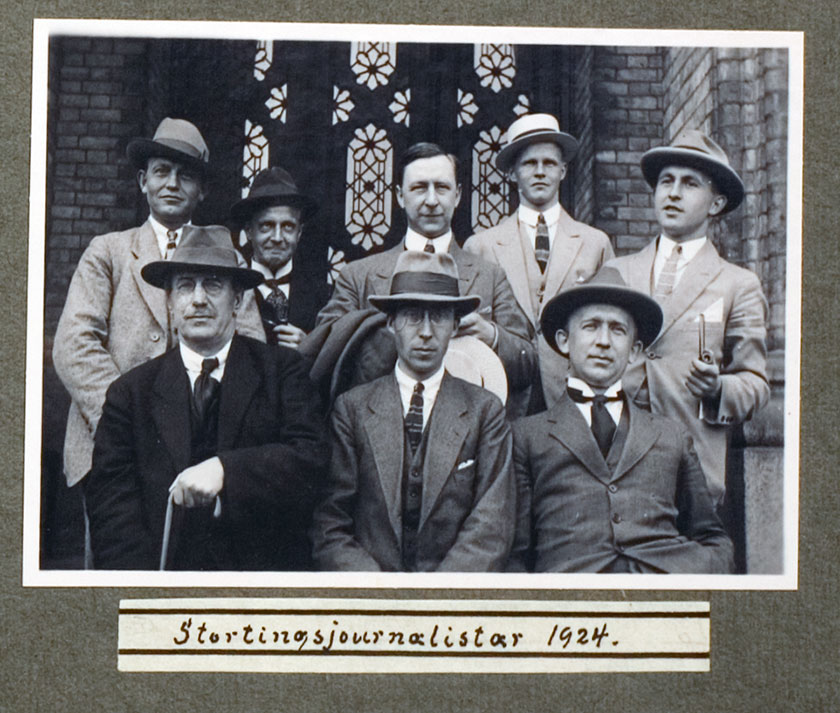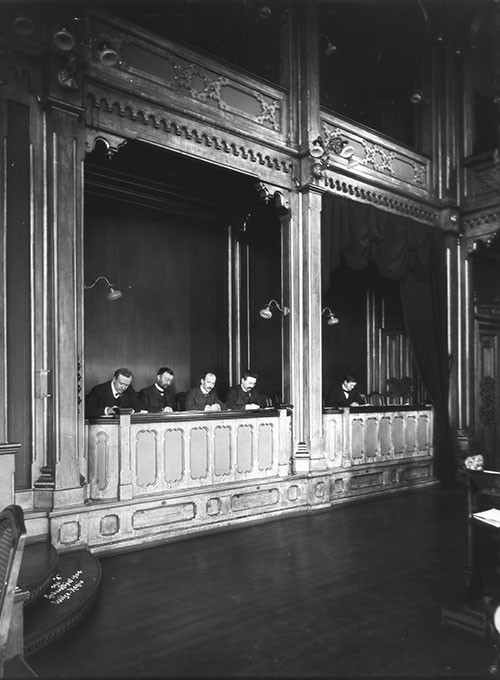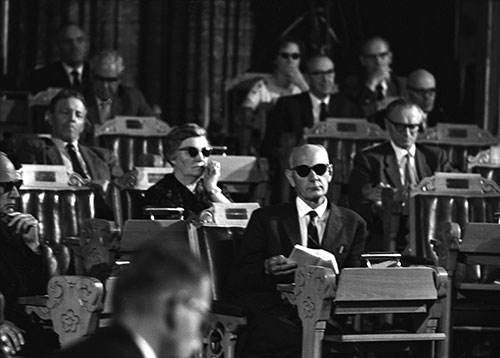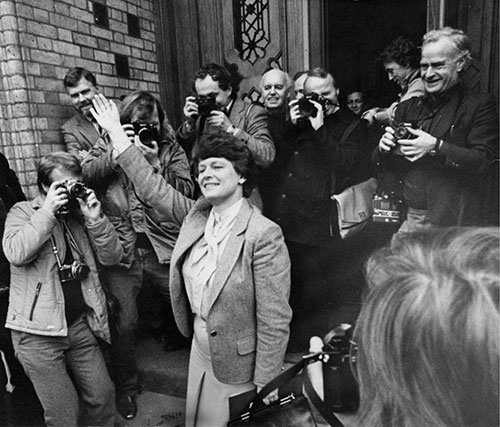
Karl Korneliussen Kleppe was a Liberal Party MP for 24 years. He liked to document daily life in the Storting. Here, members of the Parliamentary Press Club are more than willing to have their photos taken at Løvebakken in 1924. Front, left to right: Per Dahl (NTB), Anton Beinset (Den 17. Mai), Harald Torp (Aftenposten). Back, left to right: Nils Tjensvoll (Dagbladet), Harald Johannesen (Morgenbladet), Alfred Aakermann (Arbeiderbladet), Arnt Braathen (Nationen) and Rolf Werner Erichsen (Morgenbladet). Photo: Karl Korneliussen Kleppe/Storting.
100 years of the Parliamentary Press Club
A century ago this year, the journalists who cover what goes on in the Storting founded their own association. The aim of setting up the Parliamentary Press Club was to ensure that its members had acceptable working conditions.
The Storting has joined the Press Club in marking this important event by putting on a display in Eidsvolls plass outside the main entrance of the building. If you’re in Oslo at any point this summer, why not take a look at the display and learn a little bit more about the important work that the parliamentary journalists do?
Before the Parliamentary Press Club
The history of the press in the Storting is a long one. The first record of proceedings was printed in the newspaper Morgenbladet in 1821. At that time, there were no official parliamentary reporters to make sure that a complete set of minutes of what happened in the chamber was recorded. Consequently, the reports that Morgenbladet and, after a while, other newspapers wrote and published were hugely important.
When the Storting building was erected in Karl Johans gate in 1866, after extensive debate about where it should be located and what form it should take, journalists were allocated their own area in the Storting Chamber. The box, to the left of the podium, gave rise to the word presselosjen, the Norwegian name of the Parliamentary Press Club. It was the capital city’s newspapers and agencies in particular that used this space. Journalists who came from further afield were sent upstairs to the gallery.

Journalists in the press box, 1904. Photo: Anders Beer Wilse / Norwegian Museum of Cultural History.
Towards the end of the 19th Century, the founding of the first political parties led to an increase in the number of newspapers. Many of these were affiliated to the new parties. The loyal support they gave to their own particular party was reflected in the positions they took on different issues. The party press was to remain strongly entrenched in Norwegian society right up to the 1970s.
The club is founded
When the Parliamentary Press Club was founded in 1920, it comprised 15 members from 12 different editorial offices, most of which were based in the capital city. To start with, the association was loosely organized, though with an elected leader.
After Nazi Germany’s occupying forces had controlled the Norwegian media throughout World War II, life changed radically for journalists after 1945. The Parliamentary Press Club laid down its own statutes and assumed a greater role in deciding which members of the media should have access to the Storting. It became more common for members of the club to have the use of offices within the building. Journalists were also given open access to communal areas, including the Storting restaurant.
This made a huge difference to the life of the journalists who spent most of their working week in the Storting, but it also challenged the independence of the press.
The party press under pressure
The Kings Bay affair marked the breakthrough of television as a political mass medium. The mining accident on Svalbard in 1962 prompted a government crisis in Norway. The debate in the Storting in late August 1963 was the first to be broadcast live in full on national radio and television. The story was big news in Norway, and brought about a new era for the newspapers.

During the Kings Bay debate in 1963, several of the MPs wore sunglasses to protect themselves from the glare of the lamps that NRK had set up in the Chamber. Visible behind Prime Minister Gerhardsen (Labour) is his party colleague Liv Tomter, an MP for Akershus. Photo: Aage Storløkken / NTB Scanpix, 1963.
The newspapers on the political right and left had always been opposed to each other, but from this point onwards, television also gave the public direct access to what was going on. While each paper argued for its own party’s policies and opinions, the televised discussion and election programmes presented a much broader range of political views. In 1972, the debate about whether or not Norway should join the EEC concluded with an extended direct broadcast on the day of the referendum. When the votes were counted, 53.5% of the population had voted no. The result was in direct contrast to the line taken by the majority of Norwegian newspapers, which had loyally supported the “yes” campaign taken by their respective parties. As the 1970s progressed, the ties between the press and the parties weakened. By the end of the decade, the newspapers were taking a more independent view about what was happening in the Storting.
Women in the press club
When Gro Harlem Brundtland became Norway’s first female Prime Minister in 1981, the Parliamentary Press Club was dominated by men – as it had been ever since it was founded in 1920. The number of women in politics was on the rise, but it would take several years before there would be a corresponding increase in the proportion of female journalists in Parliament. This was despite the fact that Hjørdis Ånestad Tiltnes from Stavanger Aftenblad was elected first female leader of the press club as early as 1979. The most radical change occurred in the 1990s, when the proportion of women in the press club rose from 11% in 1990 to 23% a decade later.

Gro Harlem Brundtland at Løvebakken in 1981. Photo: Per Svensson / NTB Scanpix.
The Parliamentary Press Club today
Today, the Parliamentary Press Club numbers over 300 members from more than 50 different media companies. Life in the Storting has changed radically for the journalists who work there. The party press is long gone. New players have entered the stage. New platforms must be filled with content. But the essence of the journalists’ work remains the same as it has always been – to make sure that what goes on inside one of Norway’s most important institutions is open to public scrutiny.
Sist oppdatert: 17.07.2020 13:52